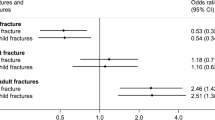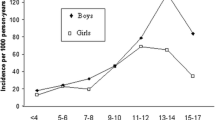Abstract
Fractures in childhood have long been considered an unavoidable consequence of growth. Studies in recent years have documented the epidemiology of these very common fractures and have also documented considerable variation by fracture type and from country to country. There have also been a number of studies aimed at identifying risk factors particularly for the most common distal forearm fracture. These studies have consistently associated bone mineral density with these fractures. Other possible risk factors include obesity, physical inactivity, sports, cola beverages, calcium intake, risk taking, and coordination. While prospective studies are required to confirm these risk factors, accumulating evidence now suggests that a substantial proportion of fractures in children are preventable.
Similar content being viewed by others
References and Recommended Reading
Johansen A, Evans RJ, Stone MD, et al.: Fracture incidence in England and Wales: a study based on the population of Cardiff. Injury 1997, 28:655–660.
Donaldson LJ, Cook A, Thomson RG: Incidence of fractures in a geographically defined population. J Epidemiol Community Health 1990, 44:241–245.
Garraway WM, Stauffer RN, Kurland LT, O’Fallon WM: Limb fractures in a defined population. I. Frequency and distribution. Mayo Clin Proc 1979, 54:701–707.
Landin L: Fracture patterns in children. Acta Orthop Scand 1983, 54(Suppl):1–109. A landmark paper on fracture incidence and risk factors in children.
Tiderius CJ, Landin L, Duppe H: Decreasing incidence of fractures in children. Acta Orthop Scand 1999, 70:622–626.
Singer BR, McLauchlan GJ, Robinson CM, Christie J: Epidemiology of fractures in 15,000 adults. J Bone Joint Surg Br 1998, 80-B:243–248.
Jones G, Cooley H: Symptomatic fracture incidence in those under 50 years of age in southern Tasmania. J Paediatr Child Health 2002, 33:278–283.
Jones IE, Williams SM, Dow N, Goulding A: How many children remain fracture-free during growth? A longitudinal study of children and adolescents participating in the Dunedin Multidisciplinary Health and Development Study. Osteoporos Int 2002, 13:990–995.
Khosla S, Melton LJ 3rd, Dekutoski MB, et al.: Incidence of childhood distal forearm fractures over 30 years: a populationbased study. JAMA 2003, 290:1479–1485. A good long term study of fracture incidence in children.
Ma D, Jones G: Television, computer and video viewing, physical activity and upper limb fracture risk in children: a population based case-control study. J Bone Miner Res 2003, 18:1970–1977. A large controlled study of physical activity and upper limb fracture risk in children.
Ma D, Morley R, Jones G: Risk-taking, coordination and upper limb fractures in children: a population based casecontrol study. Osteoporos Int 2004, In press.
Reddy SP, Junewick JJ, Backstrom JW: Distribution of spinal fractures in children: does age, mechanism of injury, or gender play a significant role? Pediatr Radiol 2003, 33:776–781.
Magnus KK, Anders M, Ralph H, et al.: A modeling capacity of vertebral fractures exists during growth-an up to 47-year follow-up. Spine 2003, 28:2087–2092.
Cooley H, Jones G: Symptomatic fracture incidence in southern Tasmania: does living in the country reduce your fracture risk? Osteoporos Int 2002, 13:317–322.
Wareham K, Johansen A, Stone MD, et al.: Seasonal variation in the incidence of wrist and forearm fractures, and its consequences. Injury 2003, 34:219–222.
Jonsson B, Bengner U, Redlund-Johnell I, Johnell O: Forearm fractures in Malmo, Sweden. Changes in the incidence occurring during the 1950s, 1980s and 1990s. Acta Orthop Scand 1999, 70:129–132.
Goulding A, Cannan R, Williams SM, et al.: Bone mineral density in girls with forearm fractures. J Bone Miner Res 1998 13:143–148.
Goulding A, Jones IE, Taylor RW, et al.: Bone mineral density and body composition in boys with distal forearm fractures: a dual-energy x-ray absorptiometry study. J Pediatr 2001, 139:509–515.
Ma D, Jones G: The association between bone mineral density, metacarpal morphometry and upper limb fractures in children: a population based case-control study. J Clin Endocrinol Metab 2003, 88:1486–1491. The largest case control study of BMD, metacarpal index, and upper limb fractures in children.
Goulding A, Jones IE, Taylor RW, et al.: More broken bones: a 4-year double cohort study of young girls with and without distal forearm fractures. J Bone Miner Res 2000, 15:2011–2018. The only cohort study of fractures in children.
Marshall D, Johnell O, Wedel H: Meta-analysis of how well measures of bone mineral density predict occurrence of osteoporotic fractures. BMJ 1996, 312:1254–1259.
Chan GM, Hess M, Hollis J, Book LS: Bone mineral status in childhood accidental fractures. Am J Dis Child 1984, 138:569–570.
Cook SD, Harding AF, Morgan EL, et al.: Association of bone mineral density and pediatric fractures. J Pediatr Orthop 1987, 7:424–427.
Landin L, Nilson BE: Bone mineral content in children with fractures. Clin Orthop 1983, 178:292–296.
Ma D, Jones G: Clinical risk factors but not bone density are associated with prevalent fractures in prepubertal children. J Paediatr Child Health 2002, 38:497–500.
Skaggs DL, Loro ML, Pitukcheewanont P, et al.: Increased body weight and decreased radial cross-sectional dimensions in girls with forearm fractures. J Bone Miner Res 2001, 16:1337–342. A novel study of CT and fracture risk in children.
Rauch F, Neu C, Manz F, Schoenau E: The development of metaphyseal cortex-implications for distal radius fractures during growth. J Bone Miner Res 2001, 16:1547–1555.
Fournier P-E, Rizzoli R, Slosman D-O et al.: Asynchrony between the rates of standing height gain and bone mass accumulation during puberty. Osteoporos Int 1997, 7:525–532.
Davidson P, Goulding A, Chalmers D: Biomechanical analysis of arm fracture in obese boys. J Paediatr Child Health 2003, 39:657–664.
Goulding A, Taylor RW, Jones IE, et al.: Overweight and obese children have low bone mass and area for their weight. Int J Obes Relat Metab Disord 2000, 24:627–632.
Goulding A, Jones IE, Taylor RW, et al.: Dynamic and static tests of balance and postural sway in boys: effects of previous wrist bone fractures and high adiposity. Gait Posture 2003, 17:136–141.
McGartland C, Robson PJ, Murray L, et al.: Carbonated soft drink consumption and bone mineral density in adolescence: the northern Ireland young hearts project. J Bone Miner Res 2003, 18:1563–1572. A large cross-sectional study of beverage intake and bone density in children.
Wyshak G, Frisch RE: Carbonated beverages, dietary calcium, the dietary calcium/phosphorus ratio, and bone fractures in girls and boys. J Adolesc Health 1994, 15:210–215.
Petridou E, Karpathios T, Dessypris N, et al.: The role of dairy products and non alcoholic beverages in bone fractures among schoolage children. Scand J Soc Med 1997, 25:119–125.
Ma D, Jones G: Soft drink and milk consumption, physical activity, bone mass and upper limb fractures in children: a population based case-control study. Calcif Tissue Int 2004, In press.
Jones G, Riley M, Dwyer T: Breastfeeding in early life and prepubertal bone mass: a longitudinal study. Osteoporos Int 2000, 11:146–152.
Bishop NJ, Dahlenburg SL, Fewtrell MS, et al.: Early diet of preterm infants and bone mineralization at age five years. Acta Paediatr 1996, 85:230–236.
Fewtrell MS, Prentice A, Jones SC, et al.: Bone mineralization and turnover in preterm infants at 8–12 years of age: the effect of early diet. J Bone Miner Res 1999, 14:810–820.
Jones G, Riley MD, Whiting S: The association between urinary potassium, urinary sodium, current diet and bone density in prepubertal children. Am J Clin Nutr 2001, 73:839–844.
Van Staa TP, Bishop N, Leufkens HG, Cooper C: Are inhaled corticosteroids associated with an increased risk of fracture in children? Osteoporos Int 2004, In press. A large study of inhaled steroid usage and fractures.
Author information
Authors and Affiliations
Rights and permissions
About this article
Cite this article
Jones, G. Growth, children, and fractures. Curr Osteoporos Rep 2, 75–78 (2004). https://doi.org/10.1007/s11914-004-0014-2
Issue Date:
DOI: https://doi.org/10.1007/s11914-004-0014-2




